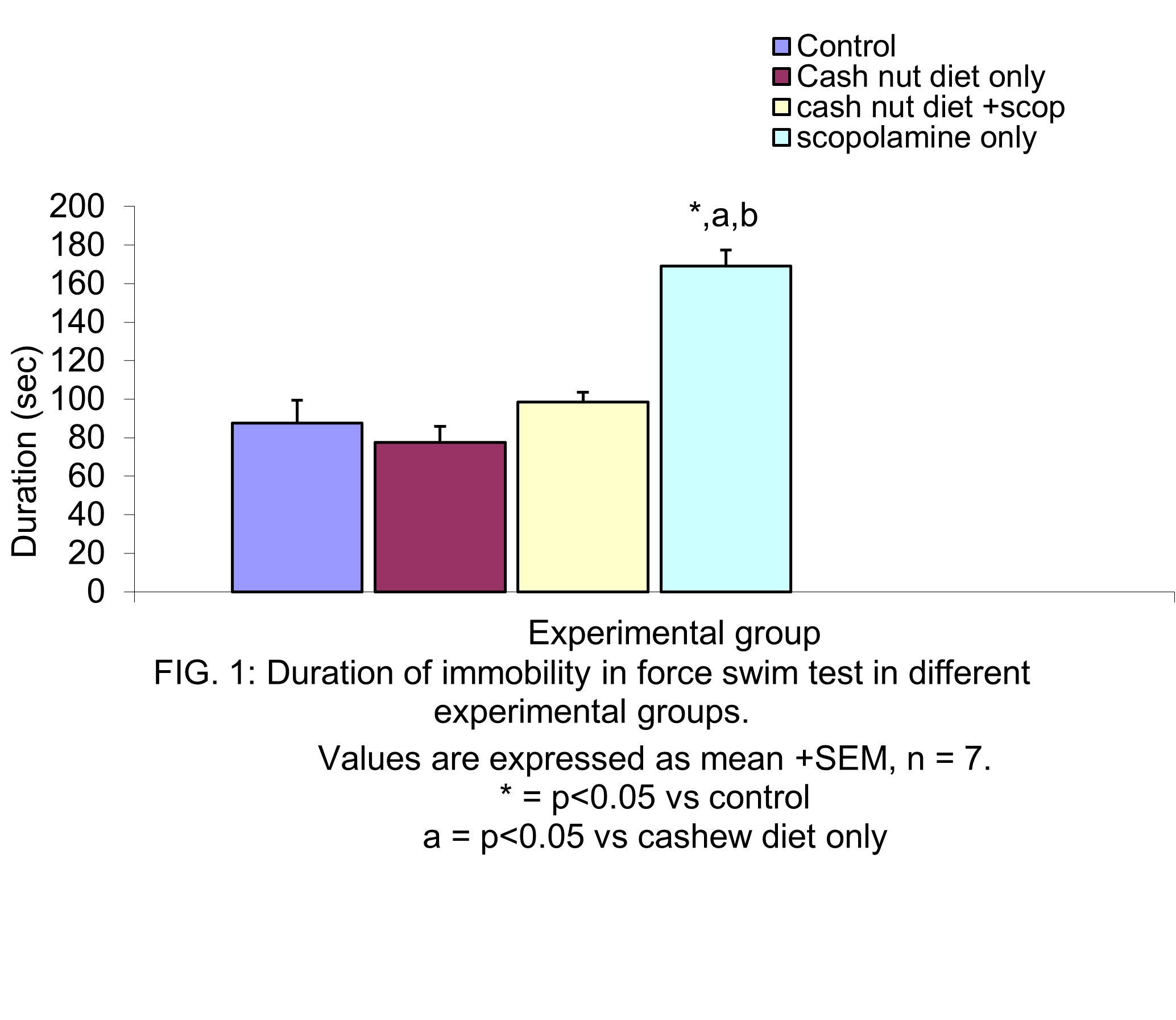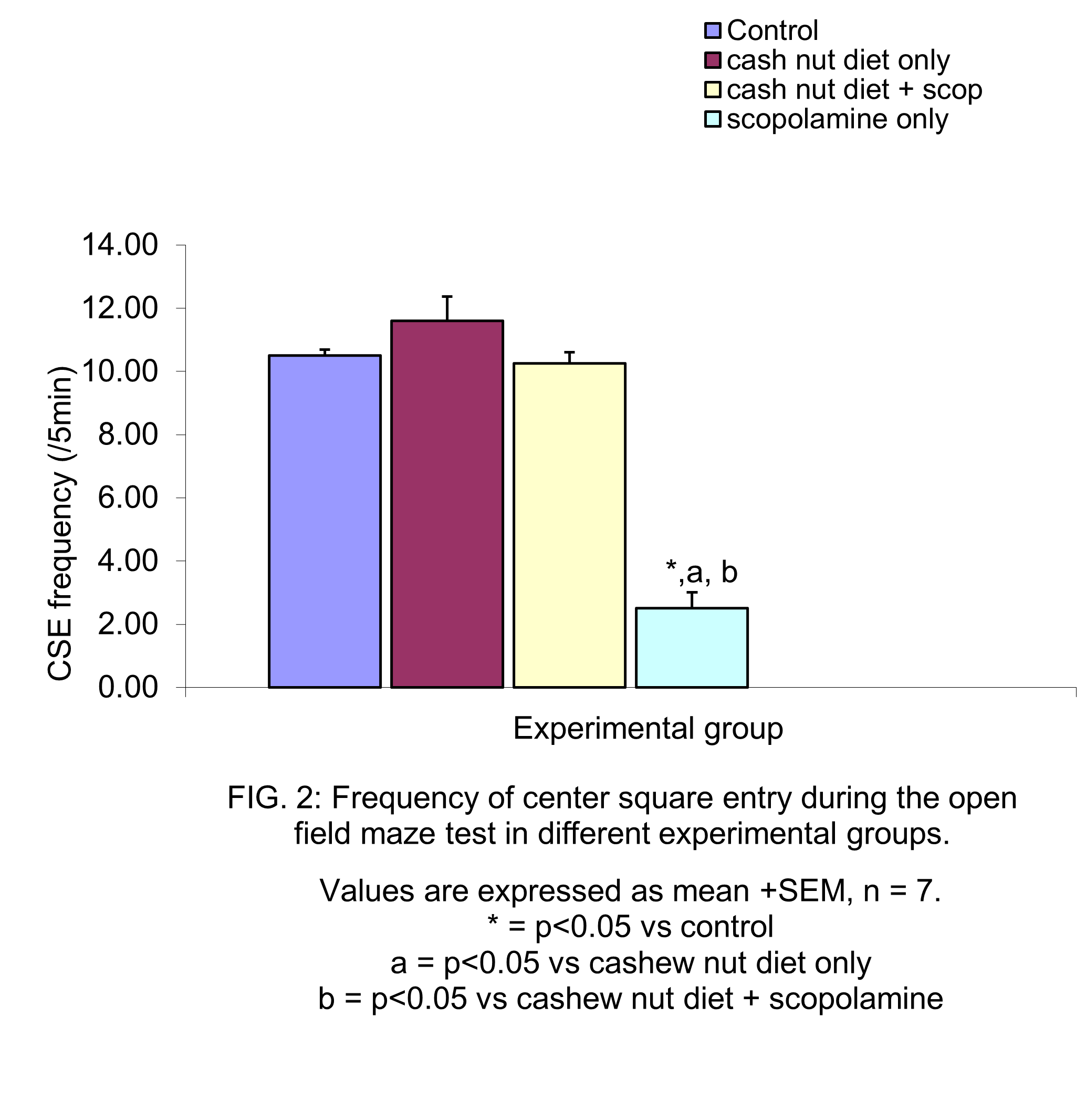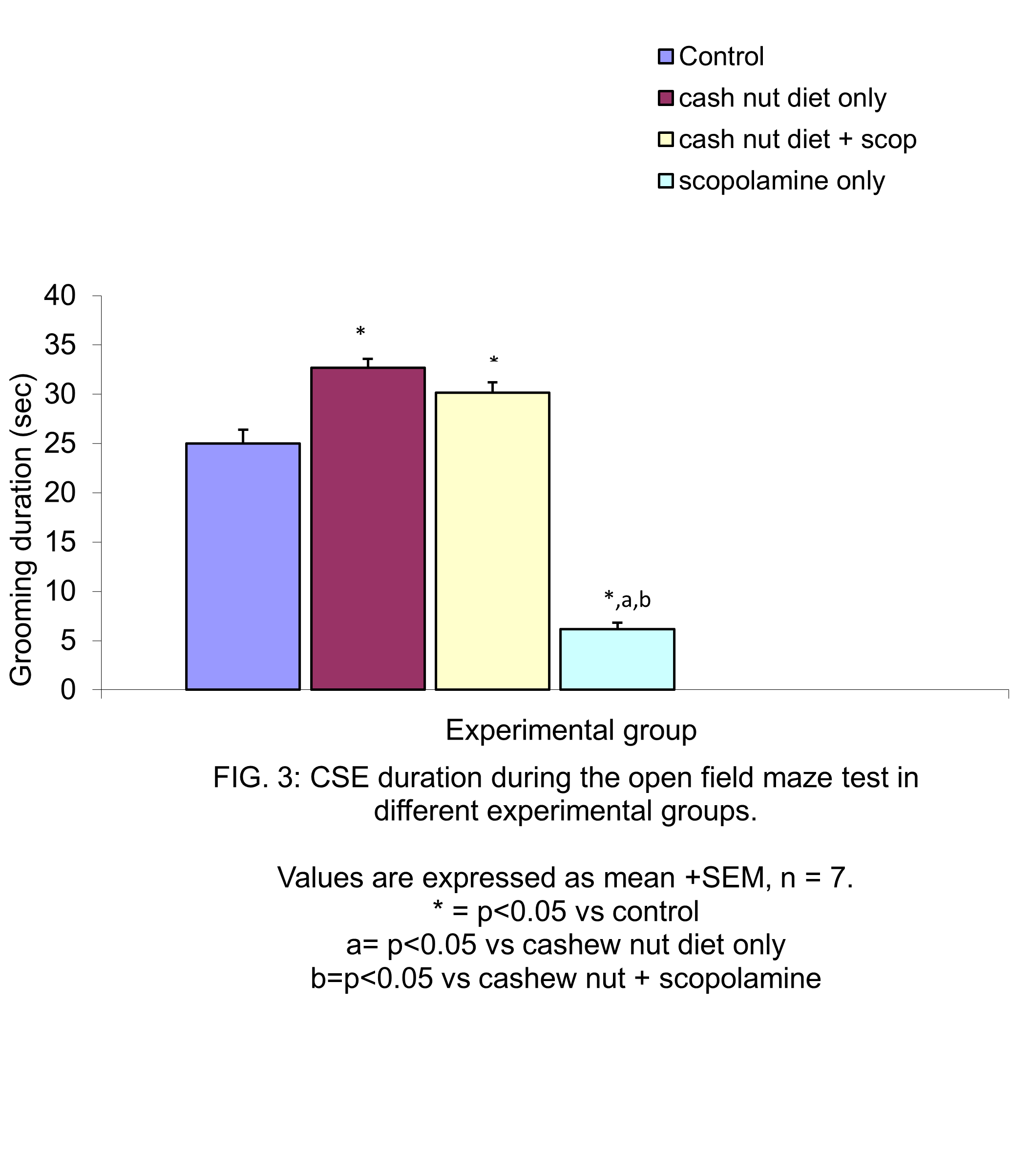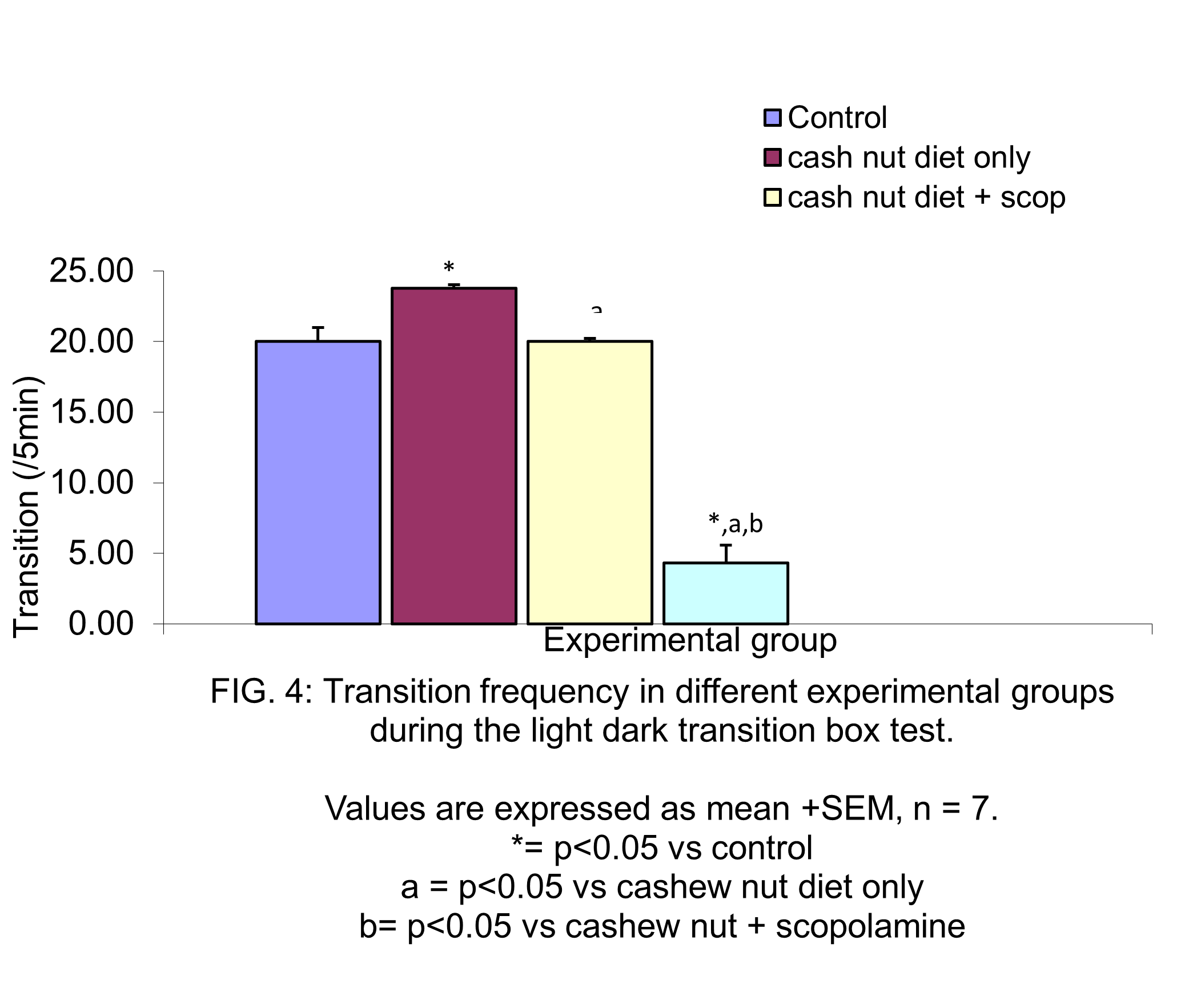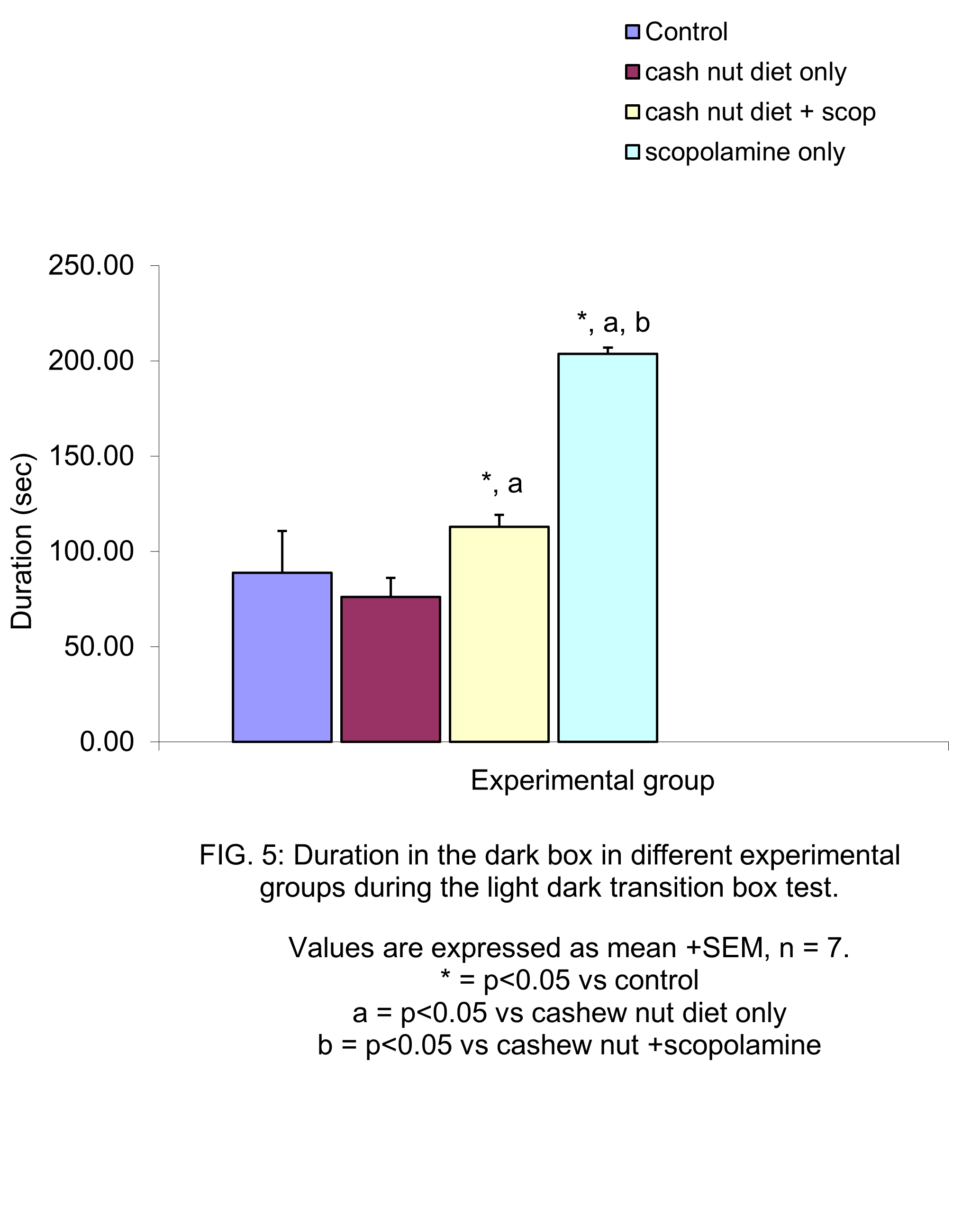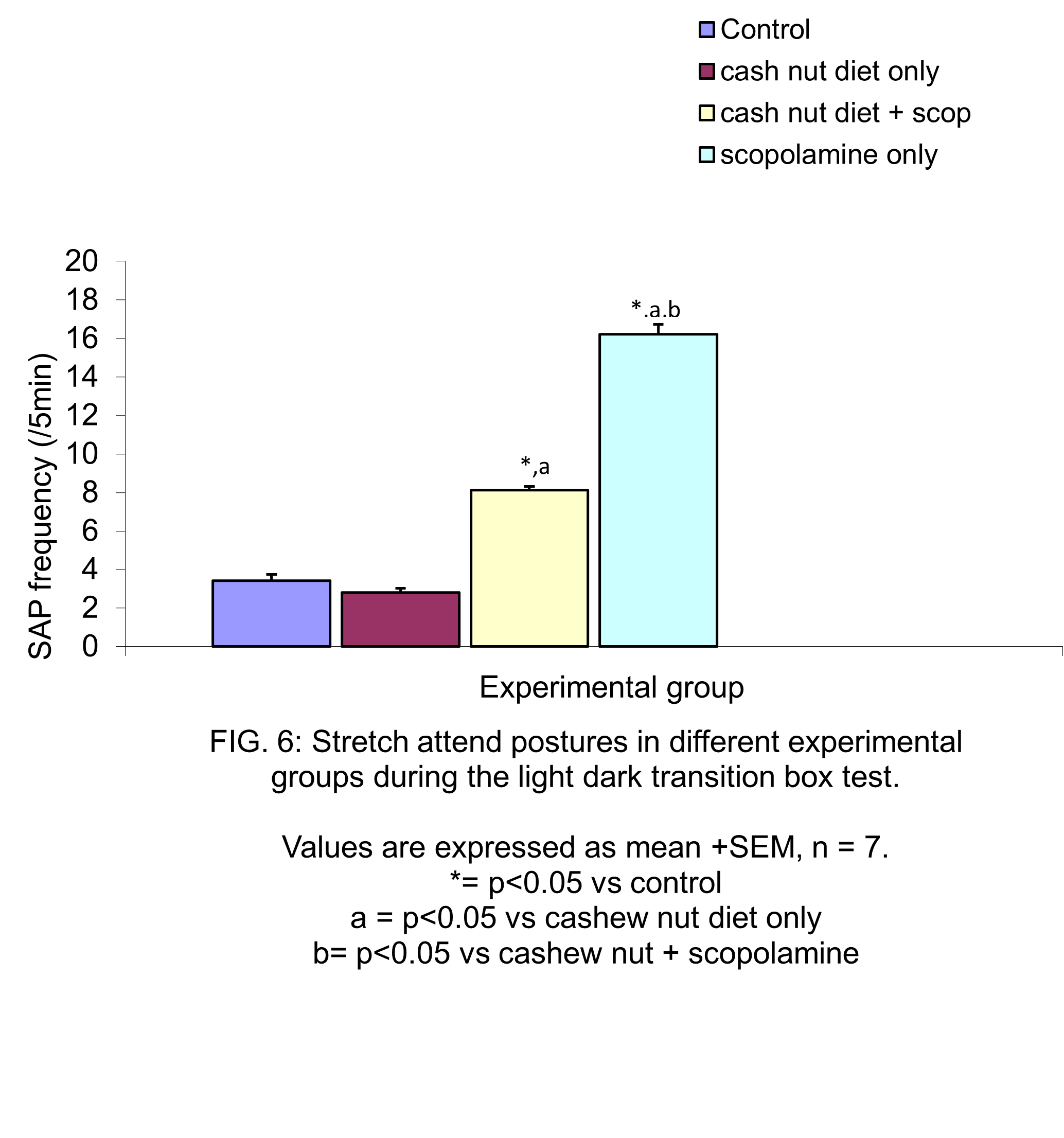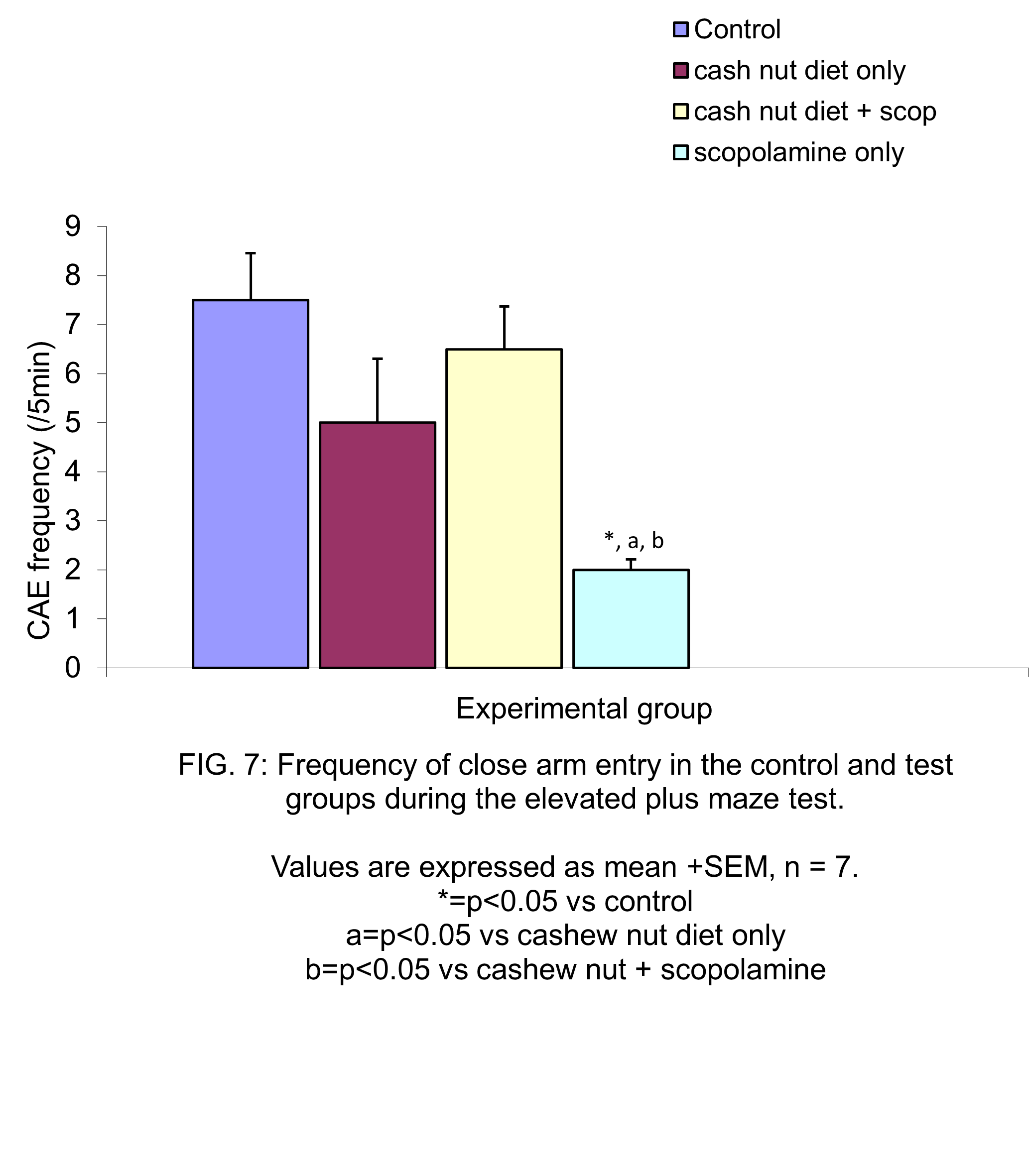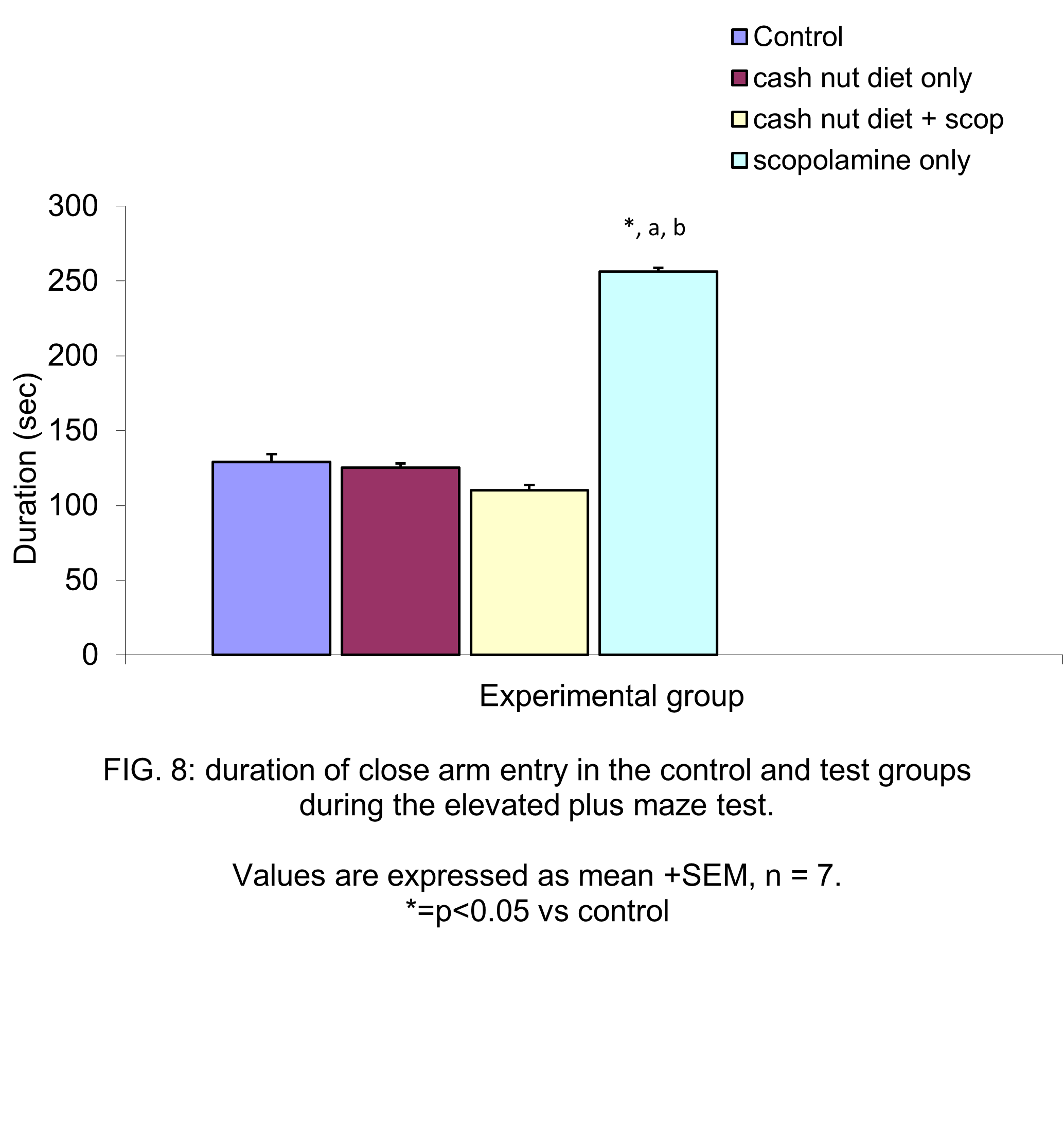The Effects of Consumption of Cashew Nut (Anacardium Occidentale) Diet on Scopolamine Induced Depression and Anxiety in CD1 Mice.
- Johnbull Martins Uket
- Christiana Godwin Gekpe
- Helyn Andonimye Ikem
- Peter Cecilia Agbo
- Nkwa Oge
- -655
- Jul 23, 2024
- Food Science
The Effects of Consumption of Cashew Nut (Anacardium Occidentale) Diet on Scopolamine Induced Depression and Anxiety in CD1 Mice.
Johnbull Martins Uket1*, Christiana Godwin Gekpe1, Helyn Andonimye Ikem1, Peter Cecilia Agbo1 and Nkwa Oge2
1Department of Physiology, Faculty of Basic Medical Sciences, College of Medical Sciences, University of Calabar, Nigeria.
2Department of physiology, faculty of medical sciences, Abia state university, Uturu , Nigeria
*Corresponding Author
DOI: https://doi.org/10.51244/IJRSI.2024.1106049
Received: 30 May 2024; Revised: 14 June 2024; Accepted: 20 June 2024; Published: 23 July 2024
ABSTRACT
Cashew nut (Anacardium occidentale) contain vitamin B6, essential amino acids (tryptophan) a precursor of serotonin and omega-3 fatty acid which had been known to affect mood. However, whether consumption of cashew nut diet which contains vitamin B6, tryptophan and omega-3 fatty acid will affect mood notably, anxiety and depression in mice has not been previously ascertained. Therefore, the effects of consumption of cashew nut (Anacardium occidentale) diets on scopolamine induced anxiety and depression in CD1 mice was studied. Twenty-eight (28) experimental mice were randomly assigned into 4 groups namely; control, cashew nut diet only, cashew nut diet + scopolamine and scopolamine only group. Forced swim test was used to assess for depression in the animals and open field maize, light/dark transition box and elevated plus maze was used to access anxiety. Results from force swim test showed that, depressive symptoms were decreased in scopolamine only treated group compared to control and other experimental groups (p<0.05). Anxiolytic behaviors were also decreased in scopolamine only treated group compared to control and other experimental groups (p<0.05). In conclusion, consumption of cashew nut diets improved depression and anxiety in mice. The anxiolytic and anti-depressive effects observed may be attributed to tryptophan, omega-3 fatty acid and vitamin B6 present in cashew nut diet.
Keywords: cashew nut, scopolamine, tryptophan, omega-3 fatty acid, vitamin B6, depression and anxiety
INTRODUCTION
Depression and anxiety are neurobehavioral disorders affecting almost every aspect of human physiology. These disorders are highly prevalent among the elderly, with severe results such as reduced quality of life and excess mortality [1]. Animal studies have shown that depression and anxiety are associated with abnormalities in hippocampus, amygdala, and prefrontal lobe [2]. Depression and anxiety disorders has consequential personal, economic, social, mental, and other health related burden on those afflicted and their relative.
Anxiety disorders are estimated to affect 26.9 million individuals in the United States at some point during their lives. DuPont et al., [3] in 1996, estimated that the annual cost of anxiety disorders is $47 billion whereas, Greenberg et al., [4] in 1999, estimated the cost at USD 42 billion. Depression is generally considered the most extensive of all physical or mental disorders among people in the early to middle years of life time [5] with cost estimated to be between $44 billion [6] and $53 billion [7]. Depression and anxiety disorders has induced considerable burden on individuals and on society with impairment to daily activities and work productivity. The burden caused by depression and anxiety is as significant as that caused by common medical illnesses. Effective antidepressant therapy restores patients’ quality of life and can alleviate the burdens on the health services caused by untreated depression and anxiety [8]. It is crystal clear that depression and anxiety has become a public health concern that requires urgent attention.
Cashew nut (Anacardium occidentale) of the family anacardium is one of the tropical fruits produced globally in large scale in some parts of Brazil, India and Vietnam [9]. The seed serves in most parts of the world as snacks or incorporated in a variety of food as source of nutrients such as protein, carbohydrate, fiber, mineral and water [10]. It has been reported that, Cashew nut have antimicrobial, antidiabetic and antioxidant effects [11], packed with essential nutrients such as vitamin B6, protein and other essential amino acids (tryptophan) which acts as natural antidepressants [12], as well as omega -3 fatty acids which is important for neural membrane functions in brain [13]. Docosahexaenoic acid (DHA) is the highest important omega-3 fatty acid in neural membrane tissues of brain with protective effects after cellular complications [14].
Scopolamine is a drug of choice in inducing memory impairment in animals including mice. The cognitive dysfunction or memory impairment observed after this drug’s usage is analogous to observations in demented patients. Scopolamine is a muscarinic receptor antagonist. It impairs long term potentiation which is responsible for long term memory [15]. It is also used as anxiogenic agent for evaluation of anxiolytic effects of new drugs. Scopolamine has also been shown to impair mood in animals [16].
Owing to the adverse effects of synthetic drugs [17], there is a search for natural remedies which are safer and effective. According to World Health Organization statistical sreport, 80% of the world’s population presently uses traditional medicine for some aspects of primary health care including mental health [18]. Therefore, natural products may provide a new source of beneficial neuropsychotropic drugs [19] provided they are scientifically validated and their mechanisms properly established.
Considering the bioactive ingredients present in cashew nut, DHA is reported to influence normal brain functions in adults [20] whereas, deficiency is associated with decline in learning and memory resulting to attention deficit a form of depression [21], and vitamin B6 combination with tryptophan helps calm the mind [22].
Since cashew nut contain DHA, vitamin B6, and serotonin precursor (tryptophan) that can affect mood, it is, therefore, evident that, the consumption of cashew nut diet may affect mood disorders such as depression and anxiety. Therefore, this study is to investigate the anti-depressive and anxiolytic effects of cashew nut (Anacardium occidentale) diet consumption on scopolamine induced depression and anxiety CD1 mice.
MATERIALS AND METHODS
Preparation of cashew nut diet: five (5) bottles of cashew nut were bought from Cost-low, a local mini market in Calabar, Nigeria. The cashew nuts were air dried and grounded into powdered form using an electric blender. The powdered form weighed 4,280g. One kilogram of grounded cashew nut was mixed with one kilogram of normal rodent chow making 50:50(w/w) 50% cashew nut diet. The diet constituent was blended in a blending machine for a uniform mixture.
Experimental animals and design: Twenty Eight (28) experimental adults CD1 mice both male and female sexes weighing 17 – 26g body weight were obtained from the animal house of Physiology Department, faculty of basic medical sciences, University of Calabar, Nigeria., were used for this study. The animals were assigned randomly into four (4) experimental groups of 7 mice in each group namely; control, cashew nut diet only, cashew nut diet plus scopolamine and scopolamine only group groups. The control group was constituted by four males and three female mice, the cashew nut diet only group was constituted by four males and three females, the cashew nut diet plus scopolamine group was constituted by four males and three female and the scopolamine only group was constituted by four males and three females. The animals were housed individually in plastic cages with wired screen top illuminated on a 12-hour light-dark cycle. The animals were allowed access to clean water and food ad libitum. The animals were allowed to acclimatize for 72 hours. Approval for the use of laboratory animals was obtained from the faculty of basic medical sciences, college of medicine Ethical Committee of University of Calabar, Nigeria on the use of experimental animals and it was in accordance with the internationally accepted principles for laboratory animal use and care as found in the European Community guide lines (EEC Directive of 1986; 86/609/EEC).
The mice in the control group were fed with normal rodent chow and administration of normal saline (1ml/kg bodyweight intraperitoneally)., The cashew nut diet group were fed with cashew nut diet and normal saline (1ml/kg bodyweight intraperitoneally)., The cashew nut diet plus scopolamine group were fed with cashew nut diet and administered scopolamine (1mg/kg bodyweight intraperitoneally) and the scopolamine only group were fed normal rodent chow and administered scopolamine (1mg/kg bodyweight intraperitoneally). All the experimental animals in the four groups were allowed access to free water and respective diet ad libitum. Scopolamine was administered once daily for the first week. In the subsequent weeks, Scopolamine was administered once every two days. The feeding was done for twenty one (21) days before laboratory test that lasted for four (4) days was done to assess depression and anxiety.
Behavioural Protocols
Forced swim test for depression: the forced swim test (FST), is used to measure features that resembles “retardative psychomotive behaviours” observed in depressive models. These features are associated with cognitive decline and reduction in mobility and increased immobility [23]. The test relies on placing animals in an inescapable and uncontrollable stress situation. A 2 Litre transparent plexiglass cylinder of 19cm tall with a diameter of 10cm was filled with tap water to 13cm (the 1600ml point) and allowed to sit overnight to attained room temperature (approximately 25 ± 2o C) [24]. The height of the water was to prevent either the tail or the feet of the animals from touching the bottom of the tank so that, the animal is not able to remain stable, without swimming, through tail contact with the bottom of the cylinder, which deceases the amount of immobility time. Since the animal models used for this study were mice, a single swim session of 6 minutes was used and during the last four minutes the duration of immobility was recorded in seconds according to the method of Can et al., (2012) [25]. A 15minute pretest session was not used, because it has been shown that, the pretest induces stable immobile behaviour in mice [26],[27]. The parameter recorded for the depression was duration of immobility in the force swim test.
Open field maze test for anxiety: The Open Field Maze (OFM) had been developed to study behaviours ranging from fear, anxiety, locomotion and exploration in rodent [28]. Currently in our laboratory, OFM is one of the mostly used apparatus to study anxiolytic behaviours in mice [29]. It enables stress free assessment of behaviors without pre-training. The easy method involved in the use of OFM have avail it wide-spread use in research ranging from several invertebrate to vertebrate species [30]. It has direct correlation between psychological and physiological concepts underlying test parameters with straight and wider understanding [31]. The OFM is constructed of plywood and measures 72 x 72 cm with 36 cm high walls. The walls and floor are both painted white. Blue lines are drawn on the floor with a marker to divide the floor into sixteen 18 x 18 cm squares. A central square of equal size is drawn in the middle of the open field (18 x 18 cm) and the floor is covered with a 72 x 72 cm piece of clear Plexiglas [32].
Procedure: Mice were carried to the test room in their home cages and were handled by the base of their tails at all times. Mice were placed into the center of the maze and allowed to explore the apparatus for 5 minutes. After the 5minute test, mice were returned into their home cages and the open field was cleaned with 70 % ethyl alcohol and permitted to dry between tests. This was to eliminate olfactory cues. To assess the process of training to the novelty of the arena, mice were exposed to the apparatus for 5 minutes on 2 consecutive days.
The Apparatus was located in a 1.8 x 4.6-m test room which is lit by a 60-watt red lamp. Each trial is recorded using a video camera-based computer tracking system (Limelight, Actimetrics) on an IBM PC computer with the camera fixed to the ceiling, 2.1 m above the apparatus and is recorded on tape as backup.
The behaviours scored for the study of anxiety [33] included: center square entry and center square duration.
Light/Dark transition box test for anxiety: The light-dark transition box is a test of unconditioned anxiety and exploratory behaviour. It is based on the conflict between exploring in a novel environment and avoidance of bright light [34].
When an animal is exposed to a novel environment there is a conflict between exploring and the tendency to avoid the unfamiliar environment. Over the years, the light/dark box has seen modification by several researchers [35]. The box has two compartments, a light and a dark one. The dark chamber is smaller and often is the compartment considered as safe by the mice.
Procedure: Mice were carried into the test room in their home cages. Each mouse was picked up by the base of its tail and placed in the center of the white compartment facing the door and allowed to explore the apparatus for 5-minutes. After 5-minutes, the mouse was removed from the box by the base of its tail and returned to the home cage. The maze was then cleaned with a solution of 70% ethyl alcohol and permitted to dry between tests. Before introducing another mouse, this procedure was carried out for all the mice.
Behaviours scored to assess anxiety included: transition, stretch attend postures and duration in the dark/light compartments.
The elevated plus maze test for anxiety: The Elevated plus Maze was built according to the description of Lister (1987). The maze has two open arms (45x5cm2) with 0.25cm high edges and two closed arms (40x5cm2) with 15cm high walls radiating from a central square (5x5cm). The open arms contain a slight ledge (4 mm high) to prevent the mice from slipping and falling off the edge [36]. The closed arms provide a sense of safety because they are enclosed like most test of anxiety. This task exploits the conflict between the natural tendency of mice to explore the novel areas and fear of open spaces. The index of open arm avoidance also gives a measure of anxiety.
Procedure: Prior to the test, the maze arms surfaces and closed sides were cleaned with Methylated spirit to eliminate olfactory cures and to remove fecal boli and urine.
Mice were placed in the central square of the plus maze such that the mice faced an open arm away from the experimenter upon placement. Immediately after placement, a quite stop watch was started and mice allowed exploring the apparatus for 5 minutes. The test session as recorded and video-recorded.
Behaviors scored to assess anxiety included: closed arm entry and closed arm duration.
Statistical Analysis:
Data obtained were presented as mean ± SEM. Experimental data were analyzed using analysis of variance (ANOVA) followed by a post hoc test (Least Square Difference (LSD) test) to determine significant difference between means. The analysis was done with an SPSS 18 statistical package. The mean values were considered significant at p<0.05.
RESULTS
Behaviours scored in Force Swim Test
Duration of Immobility in Forced swim test: Figure 1 shows the mean durations of immobility in force swim test for the control, cashew nut diet only, cashew nut diet + scopolamine and scopolamine only experimental groups of mice. The result showed that, the duration of immobility of the scopolamine only group is significantly higher compared to control and other experimental groups (p<0.05). there was no significant difference between the cashew nut diets groups compared to control.
Behaviours scored in Open Field Maze
Centre square entries: The center square entries frequency in the open field maze for control, cashew nut diet only, cashew nut diet + scopolamine and scopolamine only experimental groups of mice were 10.50 ± 0.19, 11.60 ± 0.77, 10.25 ± 0.36 and 2.50 ± 0.50 respectively. The result shows that the group treated with scopolamine only has decreased number of centre square entries compared to control and other experimental groups (p<0.05). There was no significant difference between the other experimental groups compared to control. The result is represented in 2 below.
Centre square duration: The Figure 3 below shows the duration of center square entries in the open field maze for control, cashew nut diet only, cashew nut diet + scopolamine and scopolamine only experimental groups of mice having 25.00 ± 1.38, 32.67 ± 0.90, 30.14 ± 1.08 and 6.19 ± 0.63 seconds respectively. The result shows that the scopolamine only treated group spend significantly less time in the center square compared to control and other experimental groups (p<0.05). The cashew nut only and cashew nut + scopolamine groups shown longer duration in the center square compared to control (p<0.05). there was no significant difference the cashew nut only and the cashew nut + scopolamine.
Behaviours scored in light dark transition box
Transition: The Figure 4 below shows the frequency of transitions in the light dark transition box for control, cashew nut diet only, cashew nut diet + scopolamine and scopolamine only experimental groups of mice having 20.00 ± 1.00, 23.80 ± 1.83, 20.00 ± 0.21 and 4.33 ± 1.24 respectively. From the result, the scopolamine only group shows significantly less number of transitions compared to control and other experimental groups (p<0.05). the result further shows that the group treated with cashew nut only had significant increased number of transitions compared to control and cashew nut diet + scopolamine only (p<0.05). there was no significant difference between the cashew nut + scopolamine only and the control.
Duration in the dark compartment: Figure 5 below shows the duration of times spent in the dark compartment in the light/dark transition box for control, cashew nut diet only, cashew nut diet + scopolamine and scopolamine only groups of mice having 88.89 ± 21.82, 76.08 ± 10.11, 113.00 ± 6.21 and 203.74 ± 3.24 respectively. The result shows increased duration in the scopolamine only group compared to control and other experimental groups (p<0.05). There is further indications showing increased duration in the dark compartment in cashew nut + scopolamine group compared to control and cashew nut diet only (p<0.05). there was no significant difference between the cashew nut diet only with control.
Behaviours scored in elevated plus maze
stretch attend postures: Figure 6 below shows the frequency of stretch attend posture (SAP) in the light dark transition box for control, cashew nut diet only, cashew nut diet + scopolamine and scopolamine only groups of mice having 3.43 ± 0.32, 2.81 ± 0.21, 8.12 ± 0.18 and 16.21 ± 0.53 respectively. The result shows increased number of SAP in the scopolamine only group compared to control and other experimental groups (p<0.05). The result further indicated increased number of SAP in cashew nut + scopolamine group compared to control and cashew nut diet only (p<0.05). there was no significant difference between the cashew nut diet only with control.
Frequency of close arm entry: Figure 7 below shows the frequency of entry in the close arm of elevated plus maze for control, cashew nut diet only, cashew nut diet + scopolamine and scopolamine only groups of mice having 7.50 ± 0.96, 5.00 ± 1.30, 6.50 ± 0.87 and 2.00 ± 0.21 respectively. The result shows that, the scopolamine only group had decreased frequency of entry into close arm compared to control and other experimental groups (p<0.05). there was no significant difference between the other experimental groups compared to control.
Duration in the close arm: Figure 8 below shows the duration of times spent in the dark compartment in the light/dark transition box for control, cashew nut diet only, cashew nut diet + scopolamine and scopolamine only groups of mice having 129.12 ± 4.96, 125.22 ± 2.98, 110.25 ± 3.42 and 256.22 ± 0.47 respectively. The result shows increased duration in the scopolamine only group compared to control and other experimental groups (p<0.05). There was there significant difference between the control and other experimental groups.
DISCUSSION
This study was to investigate the effect of consumption of cashew nut (anacardium occidentale) diet on scopolamine induced depression and anxiety in CD1 mice. The parameters considered in the study were depression and anxiety in CD1 mice. The force swim test was used for study of depression. Anxiety behavior was studied using the open field maze apparatus, light/dark transition box and the elevated plus maze. The administration (feeding) of cashew nut diets was done for 21 days for sufficient bioavailability of nutrients, mainly protein, fat, vitamins, minerals and dietary fiber present in cashew nut. Recent research shows that cashew nut kernels are 43% rich in lipids and 20% rich in proteins and 37% rich in inorganic constituents. The inorganic components copper and iron act as cofactors for many physiological and metabolic functions [37]. Hence transient time is needed for biogenesis of serotonin from serotonin precursor (tryptophan) present in cashew nut availability in the brain tissues.
Depression: The forced swim test for mice was developed to test rodent immobility because, it was discovered that rodents became immobile after an initial swimming activity in an inescapable situation. The duration of immobility is considered a measure of despair or depression [38]. The forced swim test result shows that the group of mice treated with scopolamine only has increased significant level of immobility compared to control, cashew nut diet only and cashew nut diet + scopolamine groups. It is possible that, the scopolamine a muscarinic receptor antagonist has induced long lasting oxidative stress in the brain of the group of mice administered scopolamine only, which may have caused damage resulting to the depressive symptoms observed in the group of mice. Whereas, the group of mice fed cashew nut did not present any depressive symptom and that could be attributed to the antioxidative components present in cashew nut diet. The group fed cashew nut + scopolamine as well did not show depressive symptoms even though scopolamine was administered, possibly because cashew nut diet contains antioxidative properties which are capable of activating cholinergic activities of serotonergic neurons in the brain centers involved in control of depression. Depression is associated with dementia [39]. The result of this work shows that, cashew nut diet improves depressive symptoms in mice models of depression. There are three parts of the brain that appear to play a role in depression: the hippocampus, amygdala, and prefrontal cortex [2].
Cortisol are a class of steroid hormones that play an important role in co-ordinating the body’s response to stress. The hippocampus stores memories and regulates the production of cortisol. The body releases cortisol during physical and mental stress, including during times of depression. long-term exposure to increased cortisol levels can slow the production of new neurons and cause the neurons in the hippocampus to shrink [40]. This can lead to memory problems. This is suspected to be a possible link between depression and dementia. Elevated cortisol levels and increased inflammation have frequently been reported in patients with depression. The prefrontal cortex regulates emotions, decision making, and forming memories [41]. When the body produces an excess amount of cortisol, the prefrontal cortex also appears to shrink. The amygdala facilitates emotional responses, such as pleasure and fear. In depressive conditions, the amygdala becomes enlarged and more active as a result of constant exposure to high levels of cortisol. An enlarged and hyperactive amygdala can result to disturbances in sleep and activity patterns causing the body to release irregular amounts of hormones and other chemicals in the body, leading to further complications [42].
It has been reported that, Cashew nut is packed with essential nutrients such as vitamin B6, protein and other essential amino acids (tryptophan) which acts as natural antidepressants [12], as well as omega -3 fatty acids which is important for neural membrane functions in brain [13]. Docosahexaenoic acid (DHA) has also been known to contain the highest important omega-3 fatty acid for neural membrane tissues of brain with protective effects after cellular complications [14]. It is possible that cashew nut diet may have increased the biosynthesis of serotonin as well as omega-3 fatty acid DHA in the brain of the mice which could have cause reduced depressive activities in our models [43]. Duan et al., (2018) [44], reported that tryptophan metabolism improved depressive condition in patience with postpartum depressive conditions. The improved depressive conditions observed in this research work may be attributed to tryptophan (serotonin precursor) and Docosahexaenoic acid. Further reports reveal that vitamin B6 combination with tryptophan helps to calm the mind [22]. The improved depressive conditions observed in this research work may be attributed to vitamin B6, tryptophan and DHA present in cashew nut.
Anxiety: The open field maze (OPM), the light/dark transition box (LDTB) and elevated plus maze (EPM) were used investigate anxiety behavior in this study. The parameters considered in the OPM for anxiety studies were center square entry and duration. The parameters considered in the LDTB were frequency of entry into the dark compartment and duration. Whereas, in the EPM, the parameters used were transition, close arm entry and duration. The use of these three apparatuses for the study of anxiety-like behavior is classified as unconditioned tests that involves methods based on measuring approach–avoidance behaviors [44].
The center square provides useful information on anxiety related problems in rodents with respect to the frequency of entry and duration in the center. A normal rodent typically placed in the OPM will acquire acclimatization to the maze and explore the entire chambers. More anxious animals usually spend significantly less time in the center square area and more time closer to the walls of the maze. Anxiolytic drugs increased the amount of time rodents spend in the open area of the maze. From the result obtained in this study the groups of mice fed cashew nut diet only and cashew nut diet + scopolamine, spend significant frequency of entries and longer duration in the center square compared to the group of mice administered scopolamine only (p<0.05).
The frequency of entries into dark compartment (transition) and duration was used to assess anxiety in the light/dark transition box. Anxious animals usually spend more time in the dark compartment than normal rodents. The results obtained from this study showed lesser number of transitions in the group administered scopolamine compared to control and the group fed cashew nut diet (p<0.05). The duration in the dark compartments increased in the group administered scopolamine compared to the groups fed cashew nut diet and control (p<0.05). EPM consists of two ‘open’ arms and two closed ‘arms’ in the shape of a plus. The open arms are aversive to mice because they are open and the maze is elevated [45]. The closed arms provide a sense of safety because they are enclosed like most tests of anxiety (the light/dark box and open field). This task exploits the conflict between the natural tendency of mice to explore novel areas and fear of open spaces. Anxiety behaviors include, closed arm activity and stretch attend posture. In the elevated plus maze, the duration of stretch attend posture was observed to be higher in the group of mice treated with scopolamine only compared to control and other experimental groups. The closed arm duration was significantly higher in the scopolamine treated group compared to cashew nut fed group and control (p<0.05). The frequency of entry into the closed arm was significantly decreased in the group treated with scopolamine compared to other experimental groups (p<0.05).
Anxious mice would normally spend more time in the closed arms of the elevated plus maze. Our result shows that the scopolamine only treated group mice showed increased level of anxiety whereas the cashew nut fed group of mice shows lower index of anxiety. Therefore, cashew nut may be suspected to contain anxiolytic properties. On the other hand, open arm avoidance by rodents in the elevated plus maze gives a measure of anxiety [46]. From our results the group of mice fed cashew nut diet exploited the open arm whereas the scopolamine treated group spend more time in the close arm avoiding the open arm. This result is consistent with the observation in the OPM and LDTB and it corroborates the fact that, there was a decreased level of anxiety in the group of mice fed with cashew nut diets.
Fear and anxiety are basically controlled by neutral circuitry involving the amygdala mostly and the hypothalamus. The amygdala is most known for processing fear and detecting threats. It acts as a guard and prepares us to protect ourselves by activating other brain/body parts. It works closely with the hippocampus as it attaches emotion to memories [47]. Electrical stimulation of the amygdala for instance, is associated with fear and feeling of terror in the animals (Osim, 2008). Field et al., (2022) [48], reported that, Vitamin B6 supplementation reduced anxiety and induced a trend towards reduced depression. Cashew nut contain vitamin B6 and tryptophan (serotonin precursor), which lessen depressive feelings and promotes the relaxation of skeletal muscle tone [49]. Thus, it is possible that the presence of these compounds and other constituents in the cashew nut diet could be responsible for the anxiolytic property of cashew nut which act by inhibiting the excitability of the amygdala by increase in the threshold of response of the cells of these nuclei, thereby reducing anxiety related behavior in the mice.
These observations can also be explained by the assertion of Young and Teff (1989) [50] that, increase level of brain serotonin facilitates the calming, relaxing and mellowing serotonin neural circuits which frequently serve to counterbalance the arousing activating dopamine/noradrenaline circuit, so that anxious, agitated emotion occurs when a person’s dopamine/noradrenaline activity arousal circuits are functioning strongly, without the calming, mellowing serotonin circuits functioning strongly as a compensatory counterbalance. It is possible that those mice did not show anxiety related behaviors because cashew nut may have increased the level of brain serotonin as shown by results in this study and thus facilitated the calming, relaxing, mellowing serotonin circuits.
In conclusion, consumption of cashew nut diet exhibited anti-depressive and anxiolytic potentials in mice fed cashew nut diet. These potentials may be attributed to tryptophan, vitamin B6, and Docosahexaenoic acid present in cashew nut diet.
REFRENCE
- Vink D, Aartsen MJ, Schoevers RA. Risk factors for anxiety and depression in the elderly: a review. Journal of affective disorders. 2008 Feb 1;106(1-2):29-44.
- Frodl T, Schaub A, Banac S, Charypar M, Jäger M, Kümmler P, Bottlender R, Zetzsche T, Born C, Leinsinger G, Reiser M. Reduced hippocampal volume correlates with executive dysfunctioning in major depression. Journal of Psychiatry and Neuroscience. 2006 Sep 1;31(5):316-23.
- DuPont RL, Rice DP, Miller LS, Shiraki SS, Rowland CR, Harwood HJ. Economic costs of anxiety disorders. Anxiety. 1996;2(4):167-72.
- Greenberg PE, Sisitsky T, Kessler RC, Finkelstein SN, Berndt ER, Davidson JR, Ballenger JC, Fyer AJ. The economic burden of anxiety disorders in the 1990s. Journal of clinical psychiatry. 1999 Jul 15;60(7):427-35.
- Murray CJ, Lopez AD, World Health Organization. The global burden of disease: a comprehensive assessment of mortality and disability from diseases, injuries, and risk factors in 1990 and projected to 2020: summary. World Health Organization; 1996.
- Greenberg PE, Kessler RC, Birnbaum HG, Leong SA, Lowe SW, Berglund PA, Corey-Lisle PK. The economic burden of depression in the United States: how did it change between 1990 and 2000?. Journal of clinical psychiatry. 2003 Dec 12;64(12):1465-75.
- Greenberg PE, Kessler RC, Nells TL, Finkelstein SN, Berndt ER. Depression in the workplace: an economic perspective. Feighner JP, Boyer WF, Selective serotonin reuptake inhibitors: Advances in Basic Research and Clinical Practice. New York: John Wiley & Sons. 1996:327-63.
- Lecrubier Y. The burden of depression and anxiety in general medicine. Journal of clinical psychiatry. 2001 Jan 1;62:4-11.
- Carvalho AL, Annoni R, Silva PR, Borelli P, Fock RA, Trevisan MT, Mauad T. Acute, subacute toxicity and mutagenic effects of anacardic acids from cashew (Anacardium occidentale Linn.) in mice. Journal of Ethnopharmacology. 2011 Jun 1;135(3):730-6.
- Aroyeun SO, Mokwunye FC, Ndagi IN, Uwagboe EO, Adeyemi EA, Yahaya LE. Developing Novel Snack ‘Dankwa’from Cashew kernel and Evaluation of its Proximate Composition, Minerals and Sensory Qualities. Int J Innovative Food Nut & Sust Agric. 2017;5:1-6.
- Shahrajabian MH, Sun W. The important nutritional and wonderful health benefits of Cashew (Anacardium occidentale L.). The Natural Products Journal. 2023 Jul 1;13(4):2-10.
- Oso AA, Ashafa AO. Nutritional composition of grain and seed proteins. Grain and seed proteins functionality. 2021 May 18:31-50.
- Alagawany M, Elnesr SS, Farag MR, El-Sabrout K, Alqaisi O, Dawood MA, Soomro H, Abdelnour SA. Nutritional significance and health benefits of omega-3,-6 and-9 fatty acids in animals. Animal Biotechnology. 2022 Dec 12;33(7):1678-90.
- Niemoller TD, Bazan NG. Docosahexaenoic acid neurolipidomics. Prostaglandins & other lipid mediators. 2010 Apr 1;91(3-4):85-9.
- Ovsepian SV, Anwyl R, Rowan MJ. Endogenous acetylcholine lowers the threshold for long‐term potentiation induction in the CA1 area through muscarinic receptor activation: in vivo study. European Journal of Neuroscience. 2004 Sep;20(5):1267-75.
- Hasselmann H. Scopolamine and depression: a role for muscarinic antagonism?. CNS & Neurological Disorders-Drug Targets (Formerly Current Drug Targets-CNS & Neurological Disorders). 2014 Jun 1;13(4):673-83.
- Deaton JG, Nappe TM. Warfarin Toxicity. 2020 Nov 21. In: StatPearls [Internet]. Treasure Island (FL): StatPearls Publishing; 2021 Jan–. PMID: 28613764.
- WHO. Traditional Medicine. World Health Organization, Geneva. 2003. https://tinyurl.com/2jjrbhe7
- Llorente AM, Jensen CL, Voigt RG, Fraley JK, Berretta MC, Heird WC. Effect of maternal docosahexaenoic acid supplementation on postpartum depression and information processing. American journal of obstetrics and gynecology. 2003 May 1;188(5):1348-53.
- Mischoulon D, Nierenberg AA, Schettler PJ, Kinkead BL, Fehling K, Martinson MA, Rapaport MH. A double-blind, randomized controlled clinical trial comparing eicosapentaenoic acid versus docosahexaenoic acid for depression. The Journal of clinical psychiatry. 2014 Sep 16;76(1):4830.
- Singh K. Nutrient and stress management. J Nutr Food Sci. 2016 Jun;6(4):528.
- Unal G, Canbeyli R. Psychomotor retardation in depression: A critical measure of the forced swim test. Behavioural brain research. 2019 Oct 17;372:112047.
- Roy M, David N, Cueva M, Giorgetti M. A study of the involvement of melanin-concentrating hormone receptor 1 (MCHR1) in murine models of depression. Biological psychiatry. 2007 Jan 15;61(2):174-80.
- Can A, Dao DT, Arad M, Terrillion CE, Piantadosi SC, Gould TD. The mouse forced swim test. JoVE (Journal of Visualized Experiments). 2012 Jan 29(59):e3638.
- De Kloet ER, Molendijk ML. Coping with the forced swim stressor: towards understanding an adaptive mechanism. Neural plasticity. 2016 Oct;2016.
- Ferreira CM, Serpa S. Society 5.0 and social development. Management and Organizational Studies. 2018 Nov;5(4):26-31.
- Hall CS. Emotional behavior in the rat. I. Defecation and urination as measures of individual differences in emotionality. Journal of Comparative psychology. 1934 Dec;18(3):385.
- Yavuz Y, Yesilay G, Guvenc Tuna B, Maharramov A, Culha M, Erdogan CS, Garip GA, Yilmaz B. Investigation of effects of transferrin-conjugated gold nanoparticles on hippocampal neuronal activity and anxiety behavior in mice. Molecular and Cellular Biochemistry. 2023 Aug;478(8):1813-24.
- Prut L, Belzung C. The open field as a paradigm to measure the effects of drugs on anxiety-like behaviors: a review. European journal of pharmacology. 2003 Feb 28;463(1-3):3-3.
- Seibenhener ML, Wooten MC. Use of the open field maze to measure locomotor and anxiety-like behavior in mice. JoVE (Journal of Visualized Experiments). 2015 Feb 6(96):e52434.
- Brown SL, Schroeder PE. Spatial patterns of aboveground production and mortality of woody biomass for eastern US forests. Ecological Applications. 1999 Aug;9(3):968-80.
- Carter M, Shieh JC. Guide to research techniques in neuroscience. Academic Press; 2015 Feb 27.
- Bourin M, Hascoët M. The mouse light/dark box test. European journal of pharmacology. 2003 Feb 28;463(1-3):55-65.
- Hascoët M, Bourin M, Colombel MC, Fiocco AJ, Baker GB. Anxiolytic-like effects of antidepressants after acute administration in a four-plate test in mice. Pharmacology Biochemistry and Behavior. 2000 Feb 1;65(2):339-44.
- Trullas R, Skolnick P. Differences in fear motivated behaviors among inbred mouse strains. Psychopharmacology. 1993 Jun;111:323-31.
- Yin R, Zhang K, Li Y, Tang Z, Zheng R, Ma Y, Chen Z, Lei N, Xiong L, Guo P, Li G. Lipopolysaccharide-induced depression-like model in mice: meta-analysis and systematic evaluation. Frontiers in Immunology. 2023 Jun 8;14:1181973.
- Argyri K, Birba A, Miller DD, Komaitis M, Kapsokefalou M. Predicting relative concentrations of bioavailable iron in foods using in vitro digestion: New developments. Food Chemistry. 2009 Mar 15;113(2):602-7.
- Fernández Fernández R, Martín JI, Antón MA. Depression as a risk factor for dementia: a meta-analysis. The Journal of Neuropsychiatry and Clinical Neurosciences. 2024 Apr;36(2):101-9.
- [39] Dronse J, Ohndorf A, Richter N, Bischof GN, Fassbender R, Behfar Q, Gramespacher H, Dillen K, Jacobs HI, Kukolja J, Fink GR. Serum cortisol is negatively related to hippocampal volume, brain structure, and memory performance in healthy aging and Alzheimer’s disease. Frontiers in aging neuroscience. 2023 May 12;15:1154112.
- Euston DR, Gruber AJ, McNaughton BL. The role of medial prefrontal cortex in memory and decision making. Neuron. 2012 Dec 20;76(6):1057-70.
- Bechara A, Damasio H, Damasio AR, Lee GP. Different contributions of the human amygdala and ventromedial prefrontal cortex to decision-making. Journal of neuroscience. 1999 Jul 1;19(13):5473-81.
- Mozaffari-Khosravi H, Yassini-Ardakani M, Karamati M, Shariati-Bafghi SE. Eicosapentaenoic acid versus docosahexaenoic acid in mild-to-moderate depression: a randomized, double-blind, placebo-controlled trial. European Neuropsychopharmacology. 2013 Jul 1;23(7):636-44.
- Duan KM, Ma JH, Wang SY, Huang Z, Zhou Y, Yu H. The role of tryptophan metabolism in postpartum depression. Metabolic brain disease. 2018 Jun;33:647-60.
- Clément Y, Calatayud F, Belzung C. Genetic basis of anxiety-like behaviour: a critical review. Brain research bulletin. 2002 Jan 1;57(1):57-71.
- Lister RG. Ethologically-based animal models of anxiety disorders. Pharmacology & therapeutics. 1990 Jan 1;46(3):321-40.
- Trullas R, Skolnick P. Differences in fear motivated behaviors among inbred mouse strains. Psychopharmacology. 1993 Jun;111:323-31.
- Phelps EA. Human emotion and memory: interactions of the amygdala and hippocampal complex. Current opinion in neurobiology. 2004 Apr 1;14(2):198-202.
- Field DT, Cracknell RO, Eastwood JR, Scarfe P, Williams CM, Zheng Y, Tavassoli T. High‐dose Vitamin B6 supplementation reduces anxiety and strengthens visual surround suppression. Human Psychopharmacology: Clinical and Experimental. 2022 Nov;37(6):e2852.
- Singh, Karuna. “Journal of Nutrition & Food Sciences.” (2016).
- Young SN, Teff KL. Tryptophan availability, 5HT synthesis and 5HT function. Progress in Neuro-Psychopharmacology & Biological Psychiatry. 1989 Jan 1;13(3-4):373-9.


